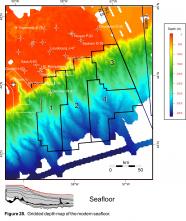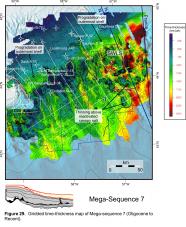Mega-sequence 7 (MS-7) – post-Eocene (duration ~34 Ma)
Mega-sequence 7 (MS-7) – post-Eocene (duration ~34 Ma)
For the time being the remainder of the Cenozoic is grouped into MS-7 – a highly complex interval on the slope that is not yet fully understood. The lower boundary of MS-7 is the top Eocene T35 marker described above. Its upper boundary is the modern seafloor (Fig. 28), a heavily canyoned surface that strongly influences the thickness map in figure 29. In general, MS-7 is thickest to the northeast where it is more than 2.5 seconds thick (twt). It also shows a general increase in thickness down the slope. On the shelf, MS-7 consists of prograding clinoforms with prominent internal erosive surfaces. Prominent Oligocene and Miocene unconformities in the lower part of MS-7 on the shelf heavily erode underlying MS-6 strata. Some canyons can be traced for more than 50 km landward of the modern shelf edge (Fig. 29).
On the slope, small scale faults, sediment waves, and contourite drifts are common, as are mass transport deposits. Two 10-12 m thick unconsolidated Miocene sands were encountered at Tantallon M-41 on the upper slope. These probable turbidite sands range from fine to coarse grained and are moderately well sorted (see Kidston et al. 2007). The amalgamated salt canopy in the SWLS was reactivated during the early pats of MS-7. In some places more than 2 seconds (twt) of down-building took place within young minibasins on the slope. Pre-existing diapirs were squeezed in the early parts of MS-7, folding MS-6 strata that draped previously inactive salt bodies. MS-7 also thins above salt that was expelled from the SWLS. This reflects a combination of stratigraphic thinning above inflated salt sheets, but also poorly understood erosion along cryptic Oligocene or Miocene unconformities (e.g. seaward end of profile D4; Fig. 11). The substantial thickening of MS-7 in the southeastern study area reflects prominent onlap of alternating blocky mass transport deposits and wavy to continuous contourite drift-like deposits in the younger part of MS-7 (e.g. seaward ends of profiles D2, D3, and D4; Figs. 10, 11). These later deposits may be related to the onset of the Laurentian Fan.



